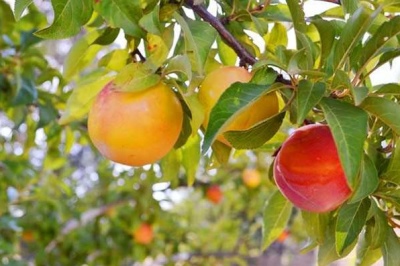
- Authors: Michurin I.V.
- Growth type: medium-sized
- Tree height, m: up to 4
- Fruit size: large
- Fruit weight, g: up to 70
- Fruit shape: rounded or oval with a not pronounced groove
- Fruit color: yellow with a greenish tint on one side and a bright orange blush on the other
- Skin : thick with a bluish waxy bloom
- Pulp (consistency): tender, juicy
- Pulp color : greenish yellow
Plum Peach Michurina is characterized by large tasty fruits, high yield and disease resistance. For 100 years now, this variety has deservedly enjoyed popularity among gardeners. Many consider this plum to be a hybrid obtained from crossing with a peach, but this is a misconception.
Breeding history
The prototype of this variety, according to some experts, was known in Western Europe back in the 19th century under the name Royal Rouge, as well as Red Nectarine. At the beginning of the 20th century, the world-famous Russian breeder Ivan Vladimirovich Michurin set the task of developing a winter-hardy variety of the Royal Rouge. In 1921 he succeeded, and a new variety of plums was born - Peach Michurina.
Description of the variety
Plum variety Peach Michurina is a medium-sized tree with dense gray-brown bark up to 4 m in height. The crown is not very dense, round in shape, with thick and strong branches. Large leaves are oval with a blunt tip. The flowering period usually occurs in July. The variety is self-fertile and needs pollinators.
Fruit characteristics
Plums of the Peach Michurina variety are large (up to 4.7 cm), the weight of one fruit is about 70 g. They are round or oval in shape, with a mild groove. The fruits are yellow with a greenish tinge on one side, on the other they have a rich orange blush. The peduncle is of medium thickness and reaches up to 1 cm in length.
Taste qualities
Plums of this variety are characterized by a sweet taste with a slight sourness. The pulp is greenish-yellow in color, tender, juicy and aromatic, it separates well from a small oval stone. The skin is quite thick, covered with a bluish waxy coating. The fruits are universal in their use, they are eaten fresh, and are also good in the form of jam, jam, compote. Plums can be stored at room temperature for about 4 days, in the refrigerator for about a month.
Ripening and fruiting
This plum is fast-growing, the first fruits appear on the 5-6th year of growth. In terms of ripening, it belongs to the late varieties. Plum Peach Michurina bears abundant fruit in late August - early September. The fruit is well attached to the tree and therefore resistant to shedding.

Yield
The average yield is up to 50 kg per plum. The maximum number of fruits can be harvested when the tree is 15 years old. The variety has a good stable yield every year.
Growing and caring
Peach Michurinskaya is an easy-to-grow home plum, especially if it grows in a warm region. For spring planting, it is recommended to choose a sunny place, this variety does not grow in the shade.The soil should be fertile and loose, preferably black earth or loam, with neutral acidity. A planting pit with a depth of 70 cm should be prepared several weeks in advance. Drainage from pebbles should be placed on the bottom, then the topsoil should be mixed with manure and coarse sand, fertilizers, for example, superphosphate or potassium chloride, can be added to the resulting mixture.
A seedling of the Peach Michurina variety should be 1-2 years old, healthy and whole, with developed roots and a height of no more than 1.5 m. Before planting, it is recommended to place the root system of the plum in a 3% solution of potassium permanganate for 11-13 hours. apply a mixture of 1 kg of clay and 500 g of rotted manure. The seedling is placed in the hole, trying to leave about 7 cm of the root collar above the ground, straighten the roots, and cover it with an earthen mixture, slightly tamping it. At the end, it is imperative to water the young tree with 20 liters of water and mulch the soil around the trunk.
When caring for the Peach Michurina plum, you need to know that it is a self-fertile variety, it needs other plums for pollination. It is better to give preference to varieties with a similar time of flower formation, for example, Anna Shpet, Green Renklod, Hungarian homemade. This plum prefers a warm climate and abundant watering in summer and during the ripening of the fruits, but you need to know that the leaves begin to turn yellow and fall off from excess moisture. Peach Michurina is frost-resistant, however, in regions with harsh winters, it requires shelter with spruce branches or straw.





Despite the fact that plum is considered more hardy than many fruit trees, it is not immune from diseases. It is attacked by viral, fungal and bacterial infections, and parasitic insects harm it. It is necessary to notice and recognize the signs of plum disease in time. They are easier to deal with and defeat early on. Well, in order to protect the garden tree from such a misfortune in the future, preventive procedures can be carried out.



































































